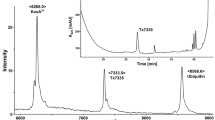Summary
ShK toxin, a 35-residue peptide isolated from the Caribbean sea anemone Stichodactyla helianthus, is a potent inhibitor of the Kv 1.3 potassium channel in lymphocytes. The natural toxin contains three disulfide bonds. The disulfide pairings of the synthetic ShK toxin were elucidated as a prerequisite for studies on its structure-function relationships. The toxin was fragmented at pH 6.5 using either thermolysin or a mixture of trypsin and chymotrypsin followed by thermolysin. The fragments were isolated by RP-HPLC and were identified by sequence analysis and MALDI-TOF mass spectrometry. The three disulfides were unambiguously identified in either proteolytic digest: Cys3 to Cys35, Cys12 to Cys28 and Cys17 to Cys32. The Cys3-Cys35 disulfide, linking the amino- and carboxyl-termini, defines the characteristic cyclic structure of the molecule. A similar disulfide pairing motif is found in the snake venom-derived potassium channel blocker dendrotoxin and the mammalian antibiotic peptide defensins.
Similar content being viewed by others
References
Karlsson, E., Aneiros, A., Casteneda, O. and Harvey, A.L., In Gopalakrishankone, P. and Tan, C.K. (Eds.) Recent Advances in Toxinology Research, Vol. 2, National University of Singapore, Singapore, 1992, pp. 378–391.
Pennington, M.W., Byrnes, M.E., Zaydenberg, I., Khaytin, I., de Chastonay, J., Krafte, D.S., Hill, R., Mahnir, V.M., Volberg, W.A., Gorczyca, W. and Kem, W.R., Int. J. Pept. Protein Res. (1995) in press.
Garcia, M.L., Galvez, A. Garcia-Calvo, M., King, V.F., Vazquez, J. and Kaczorowski, G.J., J. Bioenerg. Biomembranes, 23 (1991) 615.
Pohl, J., In Dunn, B.M. and Pennington, M.W. (Eds.) Methods in Molecular Biology, Vol. 36: Peptide Analysis Protocols, Humana Press, Totowa, NJ, 1994, pp. 107–129.
Haniu, M., Acklin, C., Kenney, W.C. and Rhode, M.F., Int. J. Pept. Protein. Res., 43 (1994) 81.
Crankshaw, M.W. and Grant, G.A. (Eds.) Identification of Modified PTH Amino Acids in Protein Sequencing Analysis, 1st ed., Association for Biomolecular Resource Facilities, Bethesda, MD, 1993.
Ellman, G.L., Arch. Biochem. Biophys. 82 (1959) 70.
Schrohenloher, R. and Bennett, J.C., In Darbre, A. (Ed.) Practical Protein Chemistry—A Handbook, Wiley, Chichester, 1994, pp. 149–163.
Pallaghy, P.K., Nielsen, K.J., Craik, D.J. and Norton, R.S., Protein Sci., 3 (1994) 1833.
Skarzynski, T., J. Mol. Biol. 224, (1992) 671.
Harvey, A.L. and Anderson, A.J., In Harvey, A.L. (Ed.) Snake Toxins. Pergamon Press, New York, NY, 1991, pp. 425–447.
Selsted, M.E. and Harwig, S.S.L., J. Biol. Chem. 264 (1989) 4003.
Author information
Authors and Affiliations
Rights and permissions
About this article
Cite this article
Pohl, J., Hubalek, F., Byrnes, M.E. et al. Assignment of the three disulfide bonds in ShK toxin: A potent potassium channel inhibitor from the sea anemone Stichodactyla helianthus . Lett Pept Sci 1, 291–297 (1995). https://doi.org/10.1007/BF00119770
Received:
Accepted:
Issue Date:
DOI: https://doi.org/10.1007/BF00119770




